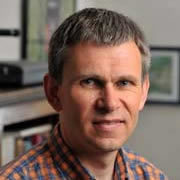Associate Professor Morten Ring Eskildsen was recently awarded a new, 3-year DOE award of $519,013 for his project "Metastable Vortex Lattices – Properties and Applications."
The collective nature of the correlated electron many-body system in the presence of magnetic fields and/or localized magnetic moments displays an astonishing variety of different phenomena. Among these one finds magnetic ordering, superconductivity, fractionally charged excitations, quantum criticality and non-Fermi liquid behavior to name just a few. One of the current grand challenges in solid state physics is to provide a microscopic understanding of superconductivity in systems where it coexists with local magnetic moments, relevant for high-Tc as well as heavy-fermion superconductors.
The current project involves small-angle neutron scattering studies of the vortex lattice (VL) in superconductors. The research is centered on the study of vortices and how the VL reflects the intrinsic nature of the superconducting state in the host materials, with a specific focus on two main topics. The first is studies of the VL in the two-band/two-gap superconductor MgB2 where an unprecedented degree of VL metastability was recently discovered, and which for the first time allow measurements of a well-ordered VL configurations besides the ground state. The second topic is studies of the VL in the heavy-fermion material UPt3 which in many ways is the paradigm of unconventional superconductivity. In this material VL metastability will allow measurements of the VL in otherwise experimentally inaccessible parts of the phase diagram. The measurements on UPt3 will be performed in collaboration with W. P. Halpering who is the John Evans Professor of Physics at Northwestern University.
Experimentally, the emphasis will be on vortex imaging by small-angle neutron scattering (SANS). Experiments will be performed at neutron facilities both in the US and abroad, including the NIST Center for Neutron Research, Oak Ridge National Laboratory, Paul Scherrer Institute in Switzerland and Institut Laue-Langevin in France.
In a broader perspective, vortices in superconductors are of crucial relevance to applications of superconductivity. The motion of vortices and the internal structure of vortices are responsible for limitations in critical electrical current density which are of direct importance to the use of superconductors for power transmission, fault regulators for the power grid, and the design and engineering of superconducting devices. It now appears that some of the most significant advances in superconductivity will be precisely in those materials which are the most complex to understand and control. This is largely owing to the fact that in many such materials the superconducting order parameter has unconventional character, as is the case for high temperature superconductors, heavy-fermion superconductors, as well as the recently discovered pnictide and chalcogenide superconductors.
